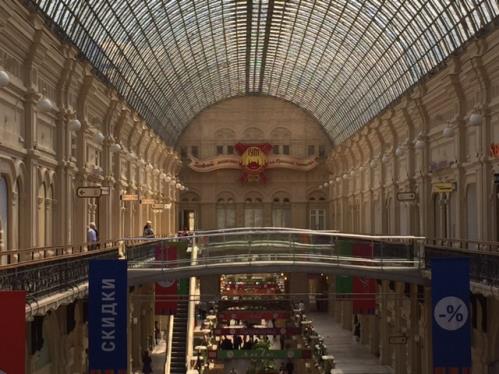
Free-market economic thinking is now being applied to Russia’s scientific sector. The GUM shopping centre in central Moscow. (Courtesy: Susan Curtis)
By Susan Curtis in Moscow
As an update to my last post, Russia’s deputy minister for science and education, Ludmila Ogorodova, accepted that the 1990s had been a period of crisis management for Russian science, and that in the 2000s plans for rebuilding the academic sector were hampered by lack of funding. But she also pointed to figures suggesting that Russian science has turned a corner over the past couple of years.
For a start, funding for R&D has increased by 40% since 2010, reaching $38bn (about £26bn) in 2014 according to figures from the OECD. Government funding, which had been languishing at 0.9% of Russia’s GDP until 2013, has now been increased to 1.19% – which she acknowledges is still some way behind the 2% of GDP invested by most western European countries. Significantly, though, corporate funding for R&D has grown by 80% since 2010, which means that state funding now only accounts for 60% of the total.
Other key metrics have shown an uptick too. Increased funding, plus a root-and-branch reform of the way research is funded, has helped to stem – and even start to reverse – the migration of Russian scientists to other parts of the world. “We have been in a negative resource potential,” says Ogorodova, referring to the large numbers of young scientists who had left Russia since the 1990s and not came back. Now, initial figures suggest that 4500 scientists have returned to Russia since 2013, while the number of scientists younger than 40 has increased by 41%.
Indicators of research quality are also seeing an improvement. Between 2000 and 2013, Russia’s national citation index – which measures the number of citations of papers published by Russian researchers as a percentage of the global total – fell below 2% for the first time. Since 2013, however, it has risen by 10% per year, now reaching 2.25%.
Ogorodova clearly realizes that this is the beginning of a journey. And the destination is not to restore a scientific sector that only supports Russian scientists, but to create an environment that attracts the best students and scientists from all parts of the world. “The movement of scientists helps to accelerate progress,” she says. “We want Russia to strengthen its position as a hub for international research.”
Ethnic Jewish scientists left USSR/Russia starting in the 1980th causing the decline in natural sciences and medicine in Russia. Michael Lerman, PhD, MD.
After the collapse of USSR, the state lost its essential control and in this situation lack of order quite a few scientists were encouraged by hostile forces including this community to leave the country; this did not do any honour to them and their dignity in this hour of need for the country.
Russian authorities should start building special cemeteries for scientists snd educators since death is very expensive now